Birds are fascinating creatures in all shapes, colours, and sizes. In our blog post today, we will be diving into the enchanting world of the Common Green Magpie. This magnificent bird is known for its vibrant green feathers and unique behaviours. We will explore its history, interesting facts, size, habitat, and classification.
The Common Green Magpie, scientifically known as Cissa chinensis, has a long and intriguing history. Native to Southeast Asian forests, this bird has captivated the hearts of bird enthusiasts for centuries. Its distinctive green plumage, contrasting black face, and bright red bill make it a standout among its avian counterparts.
In terms of size, the Common Green Magpie measures approximately 45-50 centimetres in length, including its long tail. However, its size may seem small compared to other birds, its bold and playful nature makes it impossible to overlook. Its habitat primarily consists of dense, evergreen forests where it is often found perched on tree branches or foraging on the ground for insects, fruits, and seeds.
The classification of the Common Green Magpie falls under the Phylum Chordata, Class Aves, Order Passeriformes, and Family Corvidae. Its classification within the Corvidae family means it is related to birds like crows, jays, and magpies. By understanding the classification of this beautiful creature, we can appreciate its place in the animal kingdom and its unique characteristics.
So, join us on this journey as we uncover the captivating history, intriguing facts, size, habitat, and classification of the Common Green Magpie. This bird will surely leave you in awe of the wonders that nature has to offer. And remember, if you want to learn more about various animal species, including over 155 animals, feel free to explore our other informative articles. Keep an eye on our blog for the upcoming posts where we dive deeper into the magical world of avian wonders.
History of Common Green Magpie
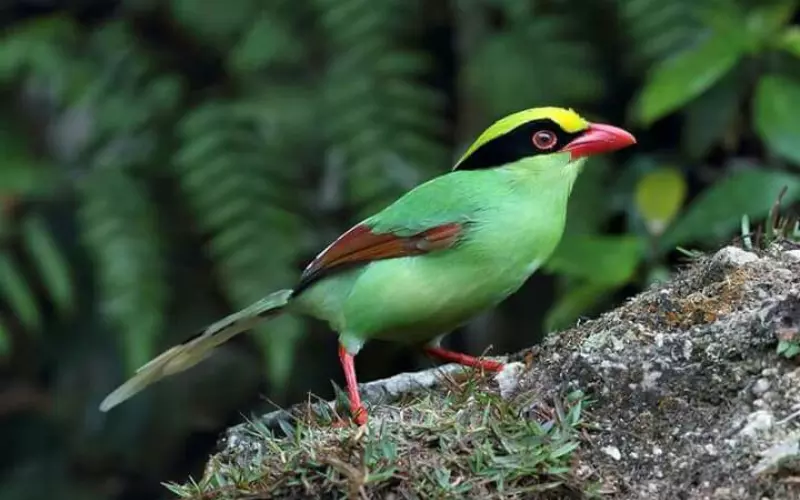
The Common Green Magpie is a species of bird that can be found in various parts of Asia. It is known for its vibrant green feathers and long, graceful tail. These birds are often seen in forests or wooded areas where they can easily find insects, fruits, and seeds to feed on. They are very social creatures, often seen in small groups or pairs.
This bird has a fascinating history, as it was once considered a symbol of good luck and prosperity in some Asian cultures. It was believed that having a Common Green Magpie visit your home would bring good fortune and happiness. Some people even kept them as pets, admiring their beautiful colours and melodious calls.
However, the Common Green Magpie population has declined over the years due to habitat loss and illegal capturing for the pet trade. Many countries have implemented strict conservation measures to protect these birds and their habitats. Efforts are being made to increase awareness about preserving their natural environment and discourage illegal hunting and capturing.
The Common Green Magpie is a beautiful bird with a significant Asian cultural history. It plays a vital role in maintaining the balance of the ecosystem by feeding on insects and dispersing seeds. We must continue to protect these birds and their habitats to ensure their survival for future generations.
Importance of Common Green Magpie

The Common Green Magpie bird plays a crucial role in our ecosystem. They are not just beautiful creatures, but they also contribute to maintaining the balance of nature. These birds are known to eat a variety of insects, including harmful pests. Feeding on these pests they help protect crops and gardens from infestations, reducing the need for pesticides that can harm the environment.
Moreover, the Common Green Magpie plays a significant role in seed dispersal. When they eat fruits, they swallow the seeds and later excrete them at different locations, allowing them to spread and grow in new areas. This helps maintain a diverse range of plant species and ensures various plants’ survival for future generations.
Additionally, Common Green Magpies indicate a healthy ecosystem in our environment. These birds thrive in regions with a well-preserved natural habitat. By protecting their habitat and ensuring their survival, we indirectly preserve the entire ecosystem, as the presence of these birds indicates a suitable environment for other species.
The Common Green Magpie bird, with its insect control abilities, seed dispersal role, and significance as an indicator of a healthy ecosystem, is an essential species we should cherish and protect. By promoting their conservation, we help the bird population and maintain a balanced and thriving environment for all living beings.
Amazing Facts About Common Green Magpie
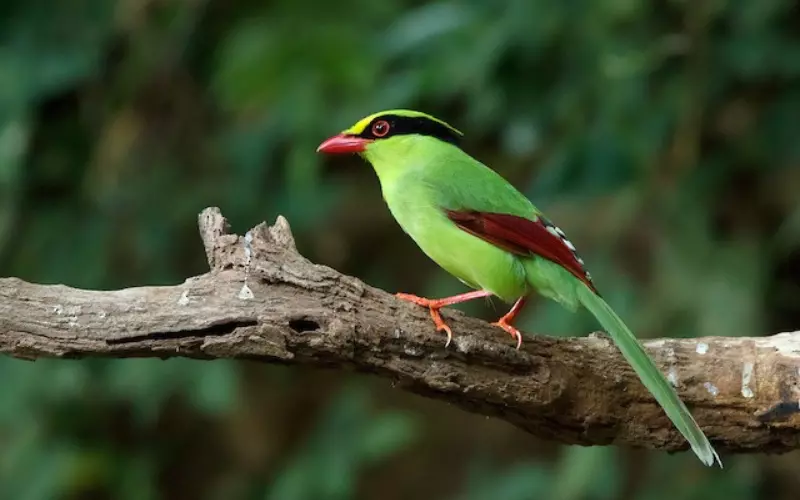
1. The Common Green Magpie is a bird species found in parts of Southeast Asia.
2. It is known for its bright green feathers, which cover its entire body, including its wings and tail.
3. Unlike many other bird species, the Common Green Magpie has a long, sleek tail that adds to its unique appearance.
4. These birds are relatively small, typically measuring around 37 to 42 centimetres in length.
5. The Common Green Magpie has a vibrant blue-coloured beak and striking red eyes, which make it easily distinguishable.
6. They are very active and agile birds, often seen jumping and climbing among trees and branches.
7. Common Green Magpies are social creatures usually found in small groups or pairs.
8. They have a musical call consisting of various high-pitched whistles and mimicry of other bird sounds.
9. These magpies have a varied diet, foraging for fruits, insects, small reptiles, and even eggs.
10. They are known to be skilled hunters, using their strong beaks and quick movements to catch prey.
11. The Common Green Magpie is a monogamous bird, meaning they form long-term mating pairs.
12. They build cup-shaped nests made of twigs, leaves, and moss, usually placed in the thick foliage of trees.
13. Female magpies usually lay 3 to 5 eggs, which are turquoise-blue and speckled with brown.
14. The male and female take turns incubating the eggs and feeding the chicks once they hatch.
15. These magpies face threats such as habitat loss due to deforestation, but they are not considered endangered.
Can we keep the Common Green Magpie as our Pet?

Keeping the Common Green Magpie as a pet is not a good idea. It is essential to understand that this bird should not be introduced or taken as a pet. The primary reason is that it is a wild bird, and keeping it as a pet can harm the bird and the environment.
Unfortunately, the Common Green Magpie is facing the threat of extinction. This means that there are very few of them left in the world. The main reasons for their dwindling population are habitat loss and illegal hunting. Their natural habitats, such as forests and woodlands, are being destroyed by human activities like deforestation. This leaves the birds with less space to live and find food.
We must protect and conserve these birds instead of keeping them as pets. When a species becomes extinct, it no longer exists in the world. Extinction is a sad event for all living beings, as it disrupts the delicate balance of nature. So, we are responsible for taking care of our environment and the animals that live with us.
We should not keep the Common Green Magpie as a pet. Understanding the importance of preserving these birds and protecting their natural habitats is essential. Extinction is a severe issue, and we must prevent it by acting responsibly towards our environment and its inhabitants.
Size of Common Green Magpie
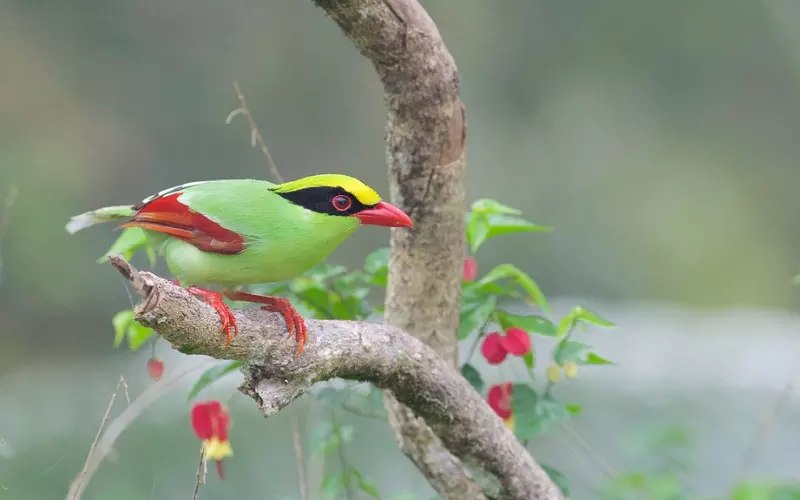
The Common Green Magpie bird is a small but striking creature. It measures approximately 45 to 60 centimetres, including its long and elegant tail. It is not very big compared to other birds, but it is still a sight to behold with its vibrant green plumage and contrasting black markings.
The body of the Common Green Magpie is slender and delicate. Its wingspan reaches about 20 to 23 centimetres wide. The bird’s beak is relatively short yet sharp, allowing it to catch insects and small creatures for food easily. With its quick movements and agile nature, it can swiftly navigate through the trees and shrubs where it usually resides.
Although small in size, the Common Green Magpie has incredible abilities. Its long and carefully designed tail enables it to balance while hopping from branch to branch. Its strong legs help it climb and grasp the tiniest twigs and leaves. With these remarkable features, the bird can move swiftly and effectively, making it a skilled hunter within its habitat.
The Common Green Magpie is a small bird measuring about 45 to 60 centimetres in length. It has a striking green colour and black markings, which stand out among other birds. Despite its size, this bird possesses remarkable skills, such as balancing on its long tail and moving swiftly through its environment.
Habitat of Common Green Magpie
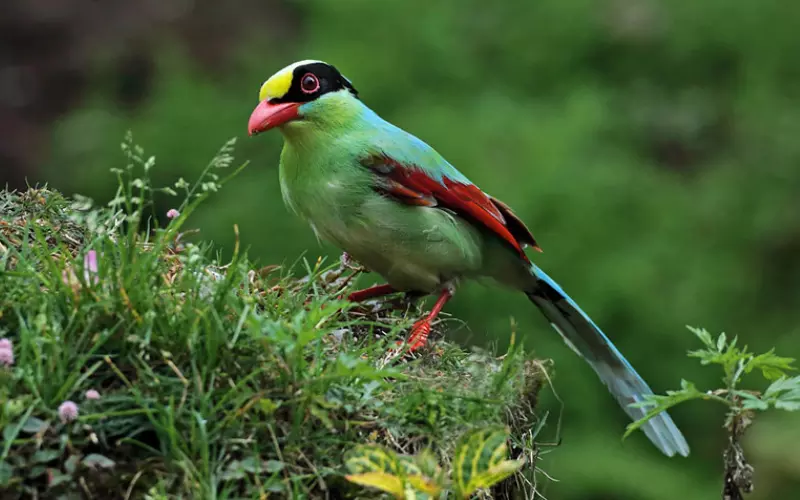
The familiar green magpie bird is found in various habitats across Southeast Asia. It prefers to live in dense forests, exceptionally tall trees and a thick canopy. These forests provide the perfect cover and protection for the bird. It can also be found in bamboo thickets, shrublands, and gardens with many trees.
The familiar green magpie likes to live in areas with plenty of water. It can be found near rivers, streams, and marshes. This is because water is essential for the bird’s survival. It needs water to drink and find food, such as insects, crustaceans, and amphibians.
The bird is often spotted in groups or pairs, making its habitat lively and energetic. It is known to be quite territorial and will defend its nesting area vigorously. The familiar green magpie is a clever and resourceful bird, using its surroundings to build nests. It often chooses tall trees or shrubs, weaving twigs, leaves, and grass together to create a secure home. The nests are usually well-hidden, making it difficult for predators to find them.
The familiar green magpie bird thrives in various habitats across Southeast Asia. It prefers dense forests with tall trees and a thick canopy, where it can find cover and protection. It also needs areas with plenty of water, such as rivers and marshes, to survive. The bird is known for its cleverness and resourcefulness in building nests and often lives in groups or pairs.
Evolution of Common Green Magpie

The Common Green Magpie bird has evolved into the magnificent creature we know today. Its evolution can be seen in three key aspects – its appearance, behaviour, and habitat.
Firstly, in terms of appearance, the Common Green Magpie has developed unique features to adapt to its surroundings. It has beautiful green feathers that help it blend in with the trees and vegetation where it lives. These feathers also serve as camouflage, making it harder for predators to spot them. Over time, the bird’s beak has become sharper and more curved, allowing it to catch insects and fruits easily. Its wings have become more robust, enabling it to fly swiftly and evade danger.
Secondly, regarding behaviour, the Common Green Magpie bird has developed certain traits to survive in its environment. It is known to be highly social, living in small groups and communicating through various calls and gestures. This behaviour helps them warn each other about potential dangers and share information about food sources. The bird’s intelligence has also evolved, allowing it to create small tools from twigs and branches to extract food from hard-to-reach places.
Lastly, regarding habitat, the Common Green Magpie bird has adapted to a specific environment. It is primarily found in the forests and woodlands of Southeast Asia. These areas provide an abundance of trees and bushes, which serve as both their home and a food source. The bird has also become adept at building nests high in the treetops, providing protection from predators and allowing them a clear view of their surroundings.
The Common Green Magpie bird’s evolution can be observed in its appearance, behaviour, and habitat. It has developed green feathers, a sharp beak, and strong wings to adapt to its surroundings. It has also become highly social, intelligent, and capable of using tools to survive. Living primarily in the forests of Southeast Asia, this magnificent bird has mastered the art of living in trees while ensuring its safety and access to food.
Classification of Common Green Magpie
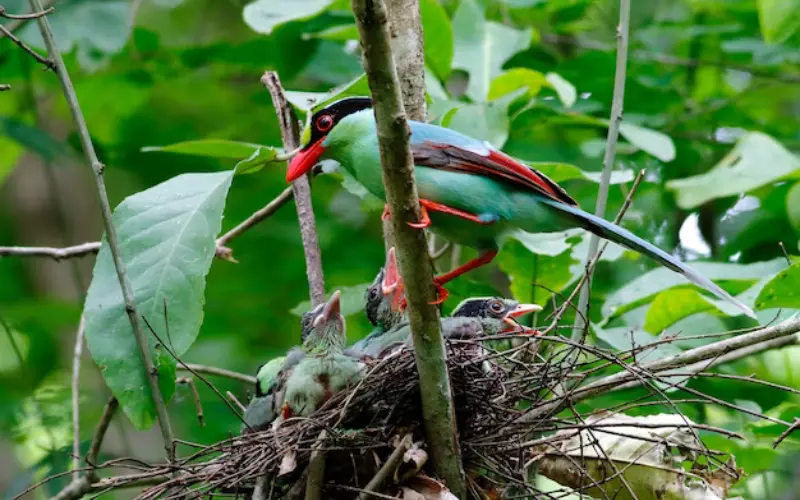
The familiar green magpie bird belongs to the Corvidae family, which includes other intelligent and talkative birds like crows and jays. Its scientific name is Cissa chinensis. This beautiful bird is native to parts of eastern and southeastern Asia, including countries like China, Taiwan, and Vietnam.
The classification of the standard green magpie starts with its kingdom, Animalia. This means that it is an animal. It belongs to the class Aves, which includes all birds. The familiar green magpie falls under the family Corvidae in the order Passeriformes, which contains over half of all bird species. This family is known for its cleverness and ability to mimic sounds.
The typical green magpie has a distinct appearance with its bright green plumage, long tail feathers, and striking black markings on its face and wings. It is a medium-sized bird, about the same size as a pigeon. This bird is quite active and can be found hopping and flying through the forest canopy, often in small groups.
The typical green magpie bird is classified within the Animalia kingdom, Aves class, Passeriformes order, and Corvidae family. Its scientific name is Cissa chinensis. Its vibrant green colours and intelligent nature make it a fascinating bird to observe in its natural habitat.
Different Types of Common Green Magpie
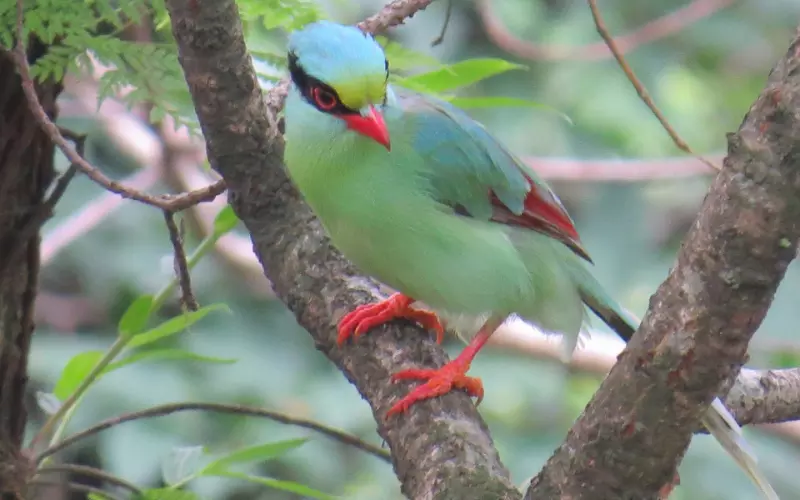
1. Greater Green Magpie: This type of green magpie is the most popular among bird enthusiasts. It has vibrant green plumage with a long tail and a distinct bluish stripe across its wings.
2. Javan Green Magpie: Found in the forests of Java, this species is known for its striking green feathers, black mask-like markings around its eyes, and an elegant crest atop its head.
3. Bornean Green Magpie: Native to Borneo, this bird has beautiful emerald green feathers and a black stripe extending from its eye to its neck. Its unique calls echo through the tropical rainforests of its habitat.
4. Sumatran Green Magpie: The Sumatran green magpie, found only on the Indonesian island of Sumatra, is characterized by its brilliant green plumage, white undertail coverts, and a vibrant blue patch on its wings.
5. Taiwan Green Magpie: Endemic to Taiwan, this species sports a combination of green, blue, and black feathers, with a prominent white throat and a long graduated tail. It is highly territorial and often seen in pairs.
6. Himalayan Green Magpie: Inhabiting the high altitudes of the Himalayas, this magpie is known for its stunning green plumage, contrasting black-and-white wings, and a long, drooping crest. It is fond of acrobatic flight displays.
7. Bornean Treepie: This green magpie, although not entirely green, is worth mentioning due to its vibrant greenish-blue hue and contrasting yellow eyes. It is native to Borneo and often resides in the canopy of tall trees.
8. Vietnamese Green Magpie: This critically endangered species is found in the forests of Vietnam. It features a bright lime green plumage, a slender bill, and a unique black-and-white pattern around its face.
9. Malabar Green Magpie: Endemic to the Western Ghats of South India, the Malabar green magpie has a striking combination of green and blue plumage, a long tail, and a raucous call that resounds in the forest canopy.
10. Siberian Green Magpie: This species is known for its stunning emerald plumage, long tail, and a streak of black across its face. It is found in Siberia and is highly adaptable to various forested habitats.
Geographical Presence of Common Green Magpie
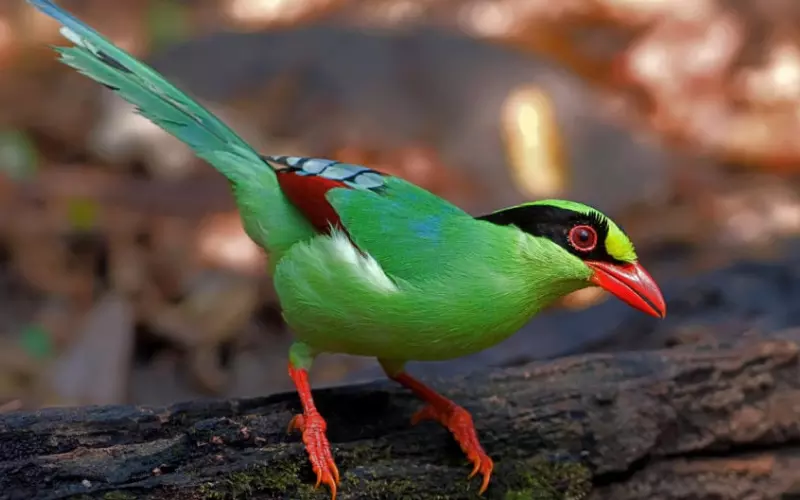
The Common Green Magpie bird is commonly found in Southeast Asia. This beautiful bird is native to India, Nepal, and Myanmar. It can also be spotted in parts of China, Thailand, and Vietnam. The Common Green Magpie is known for its striking green plumage, long tail, and bold black markings on its face and wings. Its natural habitat includes dense forests, woodlands, and bamboo thickets where it can forage for food and build its nests.
However, certain regions are where the Common Green Magpie is not found. This bird is not native to Europe, Africa, or the Americas. It prefers Southeast Asia’s warm and tropical climates, where it can find the right conditions to thrive. The Common Green Magpie is adapted to this specific environment and may not survive in other regions due to differences in climate and the availability of food sources.
The Common Green Magpie bird is found in the Southeast Asian region, including countries like India, Nepal, and Myanmar. It is known for its vibrant green plumage and can be seen in forests and woodlands. However, it is not found in other regions such as Europe, Africa, or the Americas due to differences in climate and habitat.
Scientific Name of Common Green Magpie
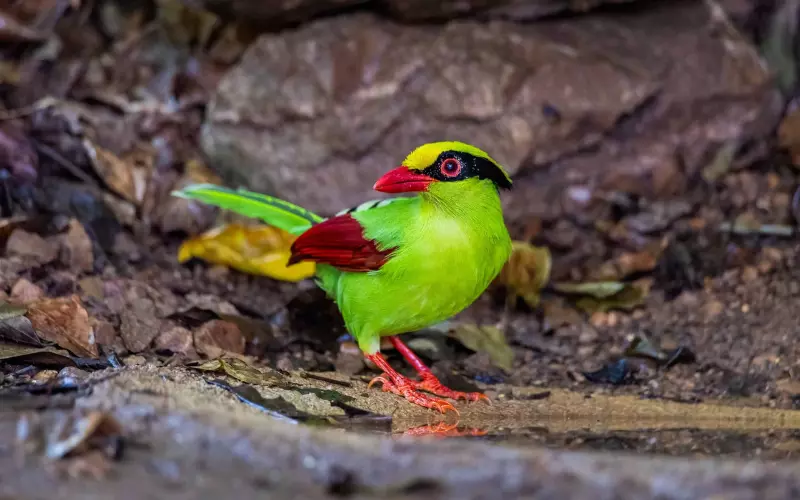
The scientific name of the Common Green Magpie bird is Cissa chinensis. This beautiful bird can be found in Bangladesh, Bhutan, India, Myanmar, and Thailand. It belongs to the crow family and is known for its stunning green colour and long tail feathers.
The Common Green Magpie bird is about the same size as a crow, with a length of around 45 to 50 centimetres. It has a bright green body, black feathers on its head, neck, and wings, and a long, elegant tail. This bird is not only known for its beautiful appearance but also its intelligent behaviour.
These magpies are often found in dense forests, where they feed on fruits, insects, and small reptiles. They are active and agile, hopping from tree to tree in search of food, and their strong beaks help them catch prey. You can often spot them in pairs or small groups, chirping loudly and displaying their vibrant plumage.
The Common Green Magpie bird, also known as Cissa chinensis, is a stunning bird with green feathers and a long tail. It can be found in countries like India and Thailand and is known for its intelligence and agility. These birds thrive in dense forests and feed on fruits, insects, and small reptiles.
Diet of Common Green Magpie

The familiar green magpie bird has a diet that mainly consists of insects. They love eating beetles, grasshoppers, caterpillars, and other bugs. They are skilled at catching their prey, using their sharp beaks and quick movements to snatch insects right out of the air. Sometimes, they even search for bugs on the ground or in trees.
In addition to insects, common green magpies also eat fruits and seeds. They enjoy feasting on berries, figs, and other tasty fruits they find. Sometimes, they may even visit gardens to eat the seeds from plants and flowers. This variety in their diet helps them to stay healthy and well-nourished.
These magpies are pretty active and agile in finding their food. They often fly from tree to tree or hop along the ground, searching for insects and fruits. They have sharp eyesight, which helps them spot their prey from a distance. Once they find something delicious, they quickly grab it with their beaks and swallow it whole.
The familiar green magpie bird has a diverse diet that includes insects, fruits, and seeds. They are intelligent and skilled hunters, using their beaks and sharp eyesight to find and catch their food. This helps them to stay energetic and robust, allowing them to thrive in their natural habitat.
Locomotion of Common Green Magpie

The Common Green Magpie bird moves around using different types of locomotion. One way it moves is by flying. It has strong wings that help it to soar through the air. It can flap its wings up and down to go upward or downward. The bird also uses its wings to glide from one place to another. This means it can glide through the air without constantly flapping its wings.
Another way the Common Green Magpie bird moves is by hopping. It can hop from one branch to another using its strong legs. This helps it to move around quickly in the trees. The bird’s legs are also crucial for perching, which means it can hold onto branches or twigs with its feet. This is how it stays balanced and doesn’t fall off. So, whether flying through the sky or hopping from branch to branch, the Common Green Magpie bird has different ways of getting around!
Social and Sexual Behaviour of Common Green Magpie
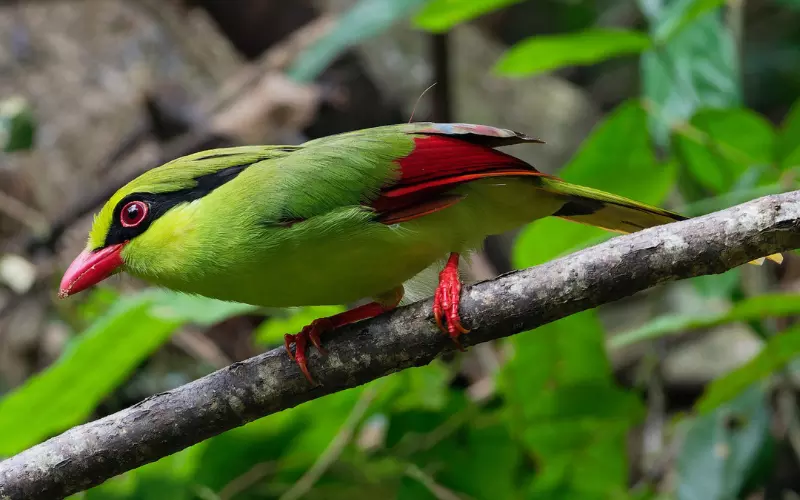
The Common Green Magpie is a magnificent bird known for its vibrant green feathers and long tail. These birds exhibit fascinating social behaviour, often seen in pairs or small groups. They communicate with each other through various calls and displays, which help them stay connected and establish their territory. These magpies are also known to engage in cooperative behaviour, sharing food and actively protecting their nests from predators, strengthening their social bond.
When it comes to the sexual behaviour of Common Green Magpies, they form monogamous pairs. This means they stay together for a long time once they find a mate. They build their nests together, searching for the perfect spot to lay their eggs and raise their chicks. The male magpies show their affection by bringing food to the female during courtship, symbolizing their commitment and dedication to each other and their future family.
These birds are truly extraordinary in their social and sexual behaviour. Their strong social bonds and monogamous relationships demonstrate the importance of communication, cooperation, and commitment in their lives. Observing the behaviour of these incredible birds can teach us valuable lessons about the significance of relationships and working together as a team for the well-being of our communities.
Reproduction and Lifecycle of Common Green Magpie
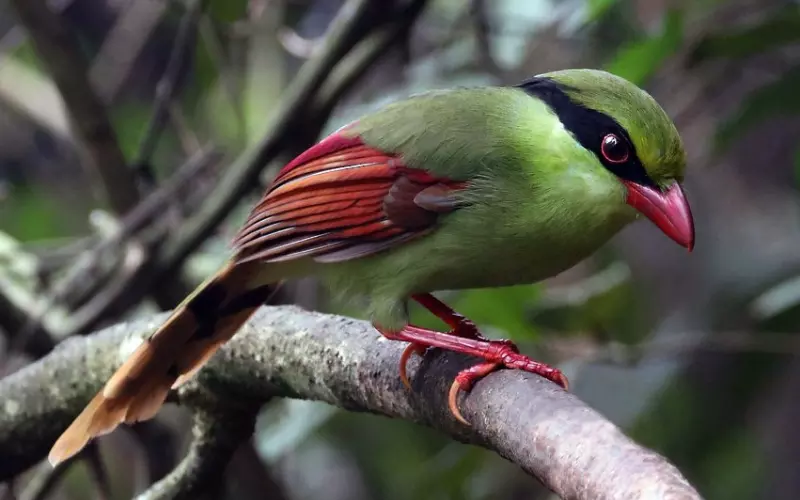
The Common Green Magpie bird has a unique and fascinating life cycle. Like most birds, it begins its life as an egg. The female magpie lays her eggs in a nest made from small branches and leaves high up in a tree. The eggs are typically light green and dotted with dark spots. The mother bird takes excellent care to keep the eggs warm and safe until they hatch.
After about two weeks, the eggs hatch, and tiny magpie chicks emerge. These chicks are born with no feathers, and their eyes are closed. They rely entirely on their parents for food and protection. The mother and father magpie take turns feeding and watching over their young ones. As the chicks grow, they develop feathers, and their eyes slowly open.
Once the chicks are fully grown and capable of flying, they leave the nest and venture into the world. They start by exploring the nearby branches, gradually building their strength and flying distances. The young magpies spend a few more weeks with their parents, learning essential skills like finding food and avoiding predators. Eventually, they leave their parents and find their territory.
The life cycle of a Common Green Magpie bird involves hatching from an egg, growing in a nest, and eventually leaving to start their independent journey. It is truly unique how these birds go from helpless chicks to capable flyers in just weeks.
Threats to Common Green Magpie

The Common Green Magpie bird is facing many threats in its natural habitat. One major threat is deforestation, which happens when people cut down trees to make space for buildings and agriculture. The birds lose their homes and food sources when the forests are destroyed. This can lead to a decline in their population. We need to protect the environment and find sustainable ways of living so as not to harm the Common Green Magpie’s habitat.
Another threat to the Common Green Magpie is hunting. Some people capture these beautiful birds for their colourful feathers or to keep them in cages as pets. This puts a lot of stress on the birds and can even lead to their death. It is cruel to capture and harm these innocent creatures, and it is our responsibility to protect them and let them live freely in the wild.
Additionally, pollution also poses a risk to the Common Green Magpie. Pollution can come from many sources, such as factories and vehicles. This can contaminate their food and water sources, making them sick or causing their death. We need to reduce our pollution by using cleaner energy sources and being more mindful of our actions.
We need to raise awareness about their conservation to protect the Common Green Magpie from these threats. We should educate people about the importance of preserving their habitat and refraining from hunting them. Governments and organizations should also enforce stricter laws and regulations to prevent deforestation and illegal capture of these birds. If we all work together, we can ensure a safe and thriving future for the Common Green Magpie bird.
The population of Common Green Magpie
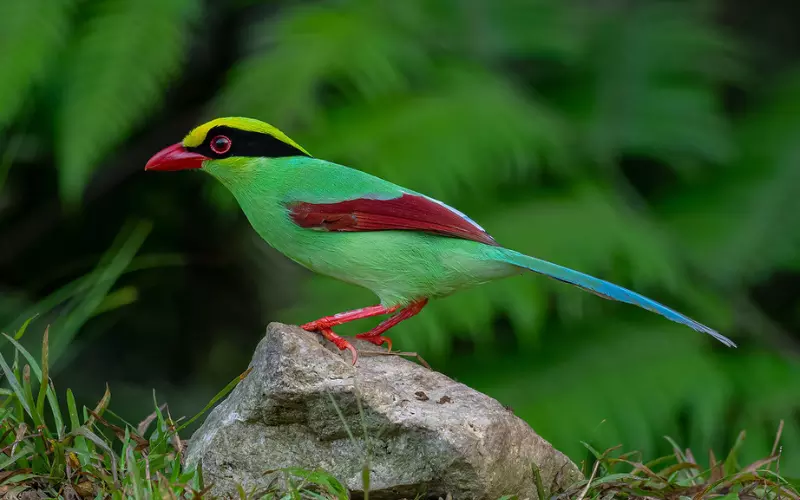
The Common Green Magpie bird population cannot be determined accurately because limited information is available. However, scientists believe there are around 100,000 to 500,000 individuals in the wild. This is just an estimated figure based on the little data that has been collected.
If this fantastic bird were extinct, it would indeed be a tragedy. Many factors could contribute to their extinction, such as habitat loss due to deforestation, pollution, and illegal hunting. These beautiful birds are an essential part of our ecosystem, helping to control pests like insects and rodents. Losing them would disrupt the balance of nature.
We must take action to protect the Common Green Magpie bird and its habitat. We can do this by spreading awareness about their importance, supporting conservation organizations, and advocating for laws that protect their natural habitats. Preserving our planet’s biodiversity is vital for the survival of all species, including the magnificent Common Green Magpie bird.
Conclusion
In today’s blog post, we have explored the captivating world of the Common Green Magpie, a fascinating bird with a rich history and intriguing facts. We have delved into its size, habitat, classification, and other exciting aspects. The Common Green Magpie, also known as Cissa chinensis, belongs to the Corvidae family, closely related to crows and jays.
The Common Green Magpie is a medium-sized bird, reaching an average length of around 45 centimetres. Its most distinctive feature is its vibrant green plumage, which sets it apart from other birds. It can be found in Southeast Asia, specifically India, Vietnam, and Indonesia. This species is known for its arboreal habitat, usually in dense forests or wooded areas.
Classification-wise, the Common Green Magpie falls under the Animal Kingdom, the Phylum Chordata, the Class Aves (birds), the Order Passeriformes, and the Family Corvidae. It is a unique and mesmerizing creature, captivating observers with its stunning appearance and distinctive calls.
The Common Green Magpie is a remarkable bird that has captured the interest of bird enthusiasts worldwide. Its history, facts, size, habitat, and classification all contribute to its undeniable allure. The vibrancy of its green plumage and arboreal lifestyle set it apart in the avian world. The Common Green Magpie is a perfect example of the incredible diversity found in the animal kingdom.
Frequently Asked Questions about Common Green Magpie (FAQ’s)
What is a Common Green Magpie bird?
The Common Green Magpie bird is a species of bird belonging to the crow family.
What is the scientific name of the Common Green Magpie bird?
The scientific name of the Common Green Magpie bird is Cissa chinensis.
Where is the Common Green Magpie bird commonly found?
The Common Green Magpie bird is commonly found in the Himalayas, Southeast Asia, and Northeast India.
What is the size of the Common Green Magpie bird?
The Common Green Magpie bird measures approximately 42-47 cm in length.
What colour is the plumage of a Common Green Magpie bird?
The plumage of a Common Green Magpie bird is predominantly green, with a black mask on its face and a long tail.
What does the diet of a Common Green Magpie bird consist of?
The diet of a Common Green Magpie bird consists mainly of fruits, insects, and small vertebrates.
How does the Common Green Magpie bird build its nest?
The Common Green Magpie bird builds its nest with twigs, roots, and leaves, usually in the canopy of trees.
Are Common Green Magpie birds social animals?
Yes, Common Green Magpie birds are known to be social animals and often live in small groups.
How does the Common Green Magpie bird communicate with other members of its group?
The Common Green Magpie bird communicates through a combination of calls, including loud screeches and soft chattering sounds.
How long does the incubation period of Common Green Magpie birds last?
The incubation period of Common Green Magpie birds usually lasts around 18-19 days.
Do Common Green Magpie birds migrate?
No, Common Green Magpie birds are not known to be migratory birds.
Can Common Green Magpie birds imitate human speech?
Yes, some Common Green Magpie birds have been observed imitating human speech to a limited extent.
Are Common Green Magpie Birds Endangered?
No, the Common Green Magpie bird is classified as a “Least Concern” species by the International Union for Conservation of Nature (IUCN).
How long does the average lifespan of a Common Green Magpie bird last?
The average lifespan of a Common Green Magpie bird is around 10-15 years.
What are the predators of Common Green Magpie birds in the wild?
Common Green Magpie birds may face predation from larger birds of prey, such as eagles and hawks, as well as from snakes and small carnivorous mammals.

Hey there, I’m Kristen Haudenschild! I’m like a superhero for animals and people.
I work as a Dependable Hard Working Supervisor, which means I help both people and animals grow and learn. I did my school at OdySea Aquarium and Georgia Southern University in Tempe, Arizona. That’s where I learned all about animals, and guess what? I’m fascinated by them!
I even write cool articles about animals. My job history includes being an Animal Trainer and a Marine Mammal Trainer II at OdySea Aquarium. I’ve also been a Senior Animal Care Specialist and an Animal Care Specialist 2.
I love exploring animals and am always ready to help others learn more about them. So, if you ever need info about animals, give me a shout!












